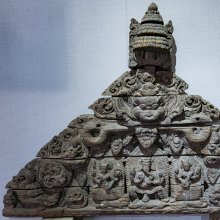Jalacara, Jala-cara: 15 definitions
Introduction:
Jalacara means something in Buddhism, Pali, Hinduism, Sanskrit, Marathi. If you want to know the exact meaning, history, etymology or English translation of this term then check out the descriptions on this page. Add your comment or reference to a book if you want to contribute to this summary article.
Alternative spellings of this word include Jalachara.
Images (photo gallery)
In Hinduism
Jyotisha (astronomy and astrology)
Source: Wisdom Library: Brihat Samhita by VarahamihiraJalacara (जलचर) refers to “creatures in water”, according to the Bṛhatsaṃhitā (chapter 4), an encyclopedic Sanskrit work written by Varāhamihira mainly focusing on the science of ancient Indian astronomy astronomy (Jyotiṣa).—Accordingly, “If the moon should pass to the south of Jyeṣṭha (the 18th constellation), Mūla (the 19th constellation) and the two Āṣāḍhas (20th and 21st constellations) she destroys seeds, creatures in water and forests [i.e., vīja-jalacara-kānana-hā]; and there will also be fear from fire. If the moon should pass to the south of Viśākhā (the 16th constellation) and Anurādhā (the 17th constellation) she will bring on evil. If she should pass through the middle of Maghā (the 10th constellation) or of Viśākhā (the 16th constellation) she will bring on prosperity”.

Jyotisha (ज्योतिष, jyotiṣa or jyotish) refers to ‘astronomy’ or “Vedic astrology” and represents the fifth of the six Vedangas (additional sciences to be studied along with the Vedas). Jyotisha concerns itself with the study and prediction of the movements of celestial bodies, in order to calculate the auspicious time for rituals and ceremonies.
In Buddhism
Tibetan Buddhism (Vajrayana or tantric Buddhism)
Source: Wisdom Library: Tibetan BuddhismJalacara (जलचर) is the name of a deity summoned by the Yamāntaka-mantra and mentioned as attending the teachings in the 6th century Mañjuśrīmūlakalpa: one of the largest Kriyā Tantras devoted to Mañjuśrī (the Bodhisattva of wisdom) representing an encyclopedia of knowledge primarily concerned with ritualistic elements in Buddhism. The teachings in this text originate from Mañjuśrī and were taught to and by Buddha Śākyamuni in the presence of a large audience (including Jalacara).

Tibetan Buddhism includes schools such as Nyingma, Kadampa, Kagyu and Gelug. Their primary canon of literature is divided in two broad categories: The Kangyur, which consists of Buddha’s words, and the Tengyur, which includes commentaries from various sources. Esotericism and tantra techniques (vajrayāna) are collected indepently.
Languages of India and abroad
Pali-English dictionary
Source: BuddhaSasana: Concise Pali-English Dictionaryjalacara : (adj.) living in the water; aquatic. (m.), a fish.

Pali is the language of the Tipiṭaka, which is the sacred canon of Theravāda Buddhism and contains much of the Buddha’s speech. Closeley related to Sanskrit, both languages are used interchangeably between religions.
Marathi-English dictionary
Source: DDSA: The Molesworth Marathi and English Dictionaryjalacara (जलचर).—n (S) A water-animal. 2 fig. A foreigner from over the seas.
Source: DDSA: The Aryabhusan school dictionary, Marathi-Englishjalacara (जलचर).—n A water-animal.
Marathi is an Indo-European language having over 70 million native speakers people in (predominantly) Maharashtra India. Marathi, like many other Indo-Aryan languages, evolved from early forms of Prakrit, which itself is a subset of Sanskrit, one of the most ancient languages of the world.
Sanskrit dictionary
Source: DDSA: The practical Sanskrit-English dictionaryJalacara (जलचर).—a. (also jalecara) aquatic. (-raḥ) 1 an aquatic animal.
2) a fish.
3) any kind of water-fowl. °आजीवः, °जीवः (ājīvaḥ, °jīvaḥ) a fisherman.
Jalacara is a Sanskrit compound consisting of the terms jala and cara (चर).
Source: Cologne Digital Sanskrit Dictionaries: Shabda-Sagara Sanskrit-English DictionaryJalacara (जलचर).—mfn.
(-raḥ-rī-raṃ) Aquatic, amphibious, going in or into water. E. jala and, and cara what goes. jale carati cara-ṭhak .
Source: Cologne Digital Sanskrit Dictionaries: Benfey Sanskrit-English DictionaryJalacara (जलचर).—[jala-cara], n. An aquatic animal, [Pañcatantra] 50, 7.
Source: Cologne Digital Sanskrit Dictionaries: Cappeller Sanskrit-English DictionaryJalacara (जलचर).—[masculine] aquatic animal, fish.
Source: Cologne Digital Sanskrit Dictionaries: Monier-Williams Sanskrit-English Dictionary1) Jalacara (जलचर):—[=jala-cara] [from jala] m. ‘water-goer’, an aquatic animal, [Rāmāyaṇa i, 44, 33; Pañcatantra; Varāha-mihira’s Bṛhat-saṃhitā; Laghujātaka, by Varāha-mihira]
2) [v.s. ...] a fish, [Varāha-mihira’s Bṛhat-saṃhitā iii, 12]
Source: Cologne Digital Sanskrit Dictionaries: Yates Sanskrit-English DictionaryJalacara (जलचर):—[jala-cara] (raḥ-rā-raṃ) a. Aquatic.
[Sanskrit to German]
Sanskrit, also spelled संस्कृतम् (saṃskṛtam), is an ancient language of India commonly seen as the grandmother of the Indo-European language family (even English!). Closely allied with Prakrit and Pali, Sanskrit is more exhaustive in both grammar and terms and has the most extensive collection of literature in the world, greatly surpassing its sister-languages Greek and Latin.
Kannada-English dictionary
Source: Alar: Kannada-English corpusJalacara (ಜಲಚರ):—[adjective] growing, living or moving in or upon water; aquatic.
--- OR ---
Jalacara (ಜಲಚರ):—
1) [noun] an aquatic animal.
2) [noun] any vessel used to move on water, as a boat, ship, etc.
--- OR ---
Jaḷacara (ಜಳಚರ):—[adjective] growing, living or moving in or upon water; aquatic.
--- OR ---
Jaḷacara (ಜಳಚರ):—
1) [noun] any aquatic animal.
2) [noun] any vessel used to move on water, as a boat, ship, etc.
Kannada is a Dravidian language (as opposed to the Indo-European language family) mainly spoken in the southwestern region of India.
Nepali dictionary
Source: unoes: Nepali-English DictionaryJalacara (जलचर):—n. aquatic animals;
Nepali is the primary language of the Nepalese people counting almost 20 million native speakers. The country of Nepal is situated in the Himalaya mountain range to the north of India.
See also (Relevant definitions)
Starts with: Jalacaraha, Jalacarajiva, Jalacarana.
Ends with: Antarjalacara.
Full-text: Jalacarajiva, Antarjalacara, Jalajantu, Jalecara, Sthalacara, Jajja, Bhucara, Simhadi, Kanana, Rava, Vija, Bija, Jiva, Cara, Graha.
Relevant text
Search found 3 books and stories containing Jalacara, Jala-cara, Jaḷa-cara, Jaḷacara; (plurals include: Jalacaras, caras, Jaḷacaras). You can also click to the full overview containing English textual excerpts. Below are direct links for the most relevant articles:
Bhakti-rasamrta-sindhu (by Śrīla Rūpa Gosvāmī)
Verse 2.4.227 < [Part 4 - Transient Ecstatic Disturbances (vyābhicāri-bhāva)]
Trishashti Shalaka Purusha Caritra (by Helen M. Johnson)
Subdivisions of Pañcendriyas < [Appendix 1.4: The nine tattvas]
Atharvaveda and Charaka Samhita (by Laxmi Maji)
Hārīta (Āyurveda scholar) < [Chapter 1 - Introduction]
2b. Tuberculosis (Yakṣmā or Rājayakṣmā) in the Caraka-Saṃhita < [Chapter 5 - Diseases and Remedies in Atharvaveda and Caraka-Saṃhitā]
